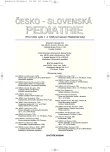Primary Hypertension in Childhood
Authors:
H. Hrstková 1; B. Fišer 2; K. Krontorádová 1; N. Honzíková 2
Authors‘ workplace:
I. dětská interní klinika, Lékařská fakulta Masarykovy univerzity a Fakultní nemocnice Brno
přednostka prof. MUDr. H. Hrstková, CSc.
1; Fyziologický ústav, Lékařská fakulta Masarykovy univerzity, Brno
vedoucí prof. MUDr. B. Fišer, CSc.
2
Published in:
Čes-slov Pediat 2008; 63 (10): 587-590.
Category:
Review
Overview
Some years ago authors started research on primary hypertension in children and adolescents, which has brought new information about the development of primary hypertension. They have been using 24-hour blood pressure monitoring and baroreflex sensitivity determination (BRS in ms/mmHg and BRSf in mHz/mmHg) in all our studies. They found BRS lower than 3.9 ms/mmHg in 5 % of healthy subjects. This value approaches the critical value for the risk of sudden cardiac death in patients after myocardial infarction and corresponds to the value present in hypertensive patients. A decreased BRS and BRSf were found not only in children with hypertension, but also in those with white-coat hypertension.
This is in accordance with a single interpretation. The decrease of BRS/BRSf precedes a pathological blood-pressure increase. Authors also studied the contribution of obesity and BRS/BRSf to the development of hypertension in adolescents. Both factors reach a sensitivity and specificity between 60 % and 65 %, but there is no correlation between the values of body mass index and BRS either in the group of hypertensive patients or in healthy controls. If a ROC (receiver operating curve) is plotted for both values together using logistic regression analysis, sensitivity higher than 70 % and specificity over 80 % are reached. This means that low baroreflex sensitivity is an independent risk factor for the development of primary hypertension. Our studies demonstrate that adolescents with increased blood pressure and with BRS under 7 ms/mmHg should be given care and intensively motivated to change their lifestyle including a change in diet and increase in physical activity.
Key words:
hypertension, baroreflex sensitivity, ambulatory blood pressure monitoring, obesity
Sources
1. Health and consumer protection directorate – general. Factsheet. In: European Communities 2006, European commission – 8 – 1049 Brussels.
2. Kaplan HM. Hypertensive and atherosclerotic cardiovascular disease. In Braunwald E, Zipes DP, Libby P. Heart Disease: A Textbook of Cardiovascular Medicine. Philadelphia: W. B. Saunders Company, 2001 : 941–948.
3. Šagát T, Šašinka M, Furková K, et al. Treatment of renal hypertension in children by Captopril. Hypertension Clin. Exp. Theory and Pract. 1986;8 : 853–857.
4. Šagát T, Šašinka M, Furková K, et al. Výskyt hypertenzie u detí a dospievajúcich s CHRI. Čs. Pediat. 1986;41 : 511–513.
5. Hrstková H, Šťastná J, Krontorádová K, et al. Ambulatorní monitorování krevního tlaku u dětí, dospívajících a mladých dospělých 10 let po léčbě antracykliny. In: Skopec F. Sborník 17. konference dětských hematologů a onkologů České a Slovenské republiky s mezinárodní účastí. Špindlerův Mlýn: Nucleus HK, 2007 : 107.
6. Honzikova N, Labrova R, Fiser B, et al. Influence of age, body mass index, and blood pressure on the carotid intima-media thickness in normotensive and hypertensive patients. Biomed. Tech. 2006;51(4): 159–162.
7. Filippone JD, Bisognano JD. Baroreflex stimulation in the treatment of hypertension. Curr. Opin. Nephrol. Hypertens. 2007;16 : 403–408.
8. Honzíková N, Fišer B, Honzík J. Noninvasive determination of baroreflex sensitivity in man by means of spectral analysis. Physiol. Res. 1992;41 : 31–37.
9. Gribbin B, Pickering TG, Sleight P, et al. Effect of age and high blood pressure on baroreflex sensitivity in man. Circ. Res. 1971;24 : 424–431.
10. Semrád B, Fišer B, Honzíková N. Ageing and cardiac autonomic status. In: Malik M. Clinical Guide to Cardiac Autonomic Tests. Boston, London: Kluwer Academic Publishers, Dordrecht, 1998 : 285–300.
11. Zavodna E, Honzikova N, Hrstkova H, et al. Can we detect the development of baroreflex sensitivity in humans between 11 and 20 years of age? Can. J. Physiol. Pharmacol. 2006;84(12): 1275–1283.
12. Honzíková N, Semrád B, Fišer B, et al. Baroreflex sensitivity determined by spectral method and heart rate variability, and two-years mortality in patients after myocardial infarction. Physiol. Res. 2000;49 : 643–650.
13. Honzíková N, Nováková Z, Závodná E, et al. Baroreflex sensitivity in children, adolescents, and young adults with essential and white-coat hypertension. Klin. Paed. 2006;218(4): 237–242.
14. Krontoradova K, Honzikova N, Fiser B, et al. Overweight and decreased baroreflex sensitivity as independent risk factors for hypertension in children, adolescents, and young adults. Physiol. Res. 2008;57 : 385–391.
Labels
Neonatology Paediatrics General practitioner for children and adolescentsArticle was published in
Czech-Slovak Pediatrics

2008 Issue 10
- What Effect Can Be Expected from Limosilactobacillus reuteri in Mucositis and Peri-Implantitis?
- The Importance of Limosilactobacillus reuteri in Administration to Diabetics with Gingivitis
Most read in this issue
- Henoch-Schönlein Purpura from the Standpoint of Preventive Corticoid Administration
- Assessment of Clinical Signs of Intracranial Hypertension in Newborns and Infants with Hydrocephalus in Relationship to the Indication of Drainage Procedure
- Heterotopy of Stomach Mucosa – Review of Literature and Our Experience
- Prader-Willi Syndrome in Newborns – Two Case Reports
